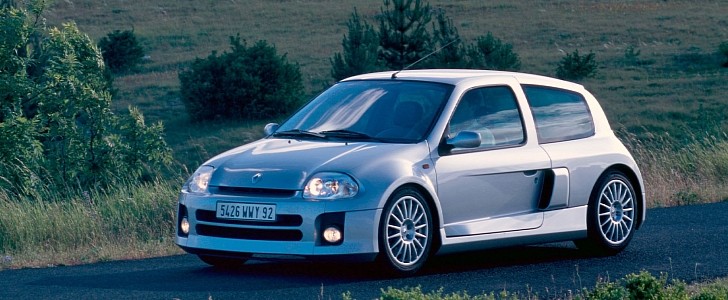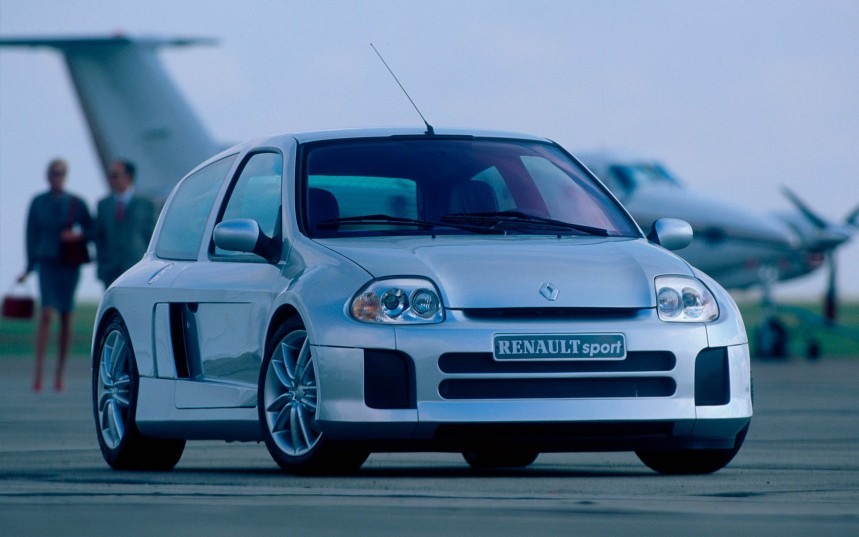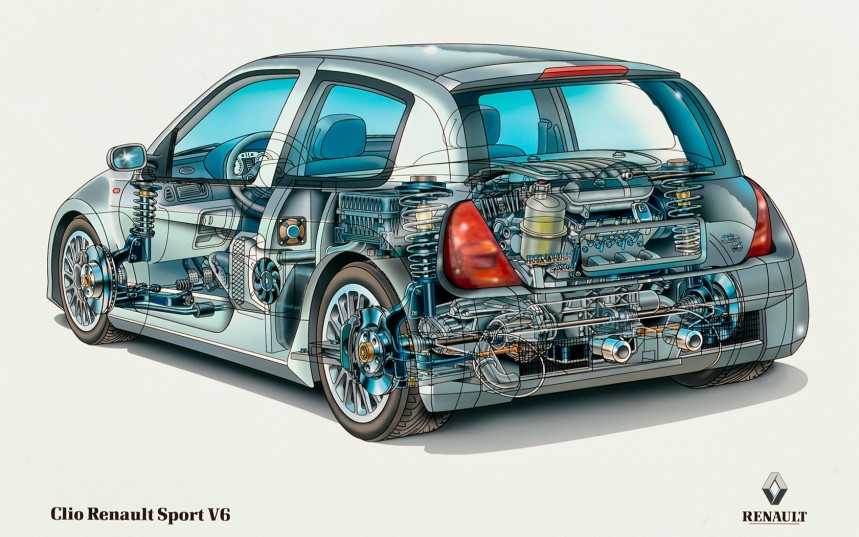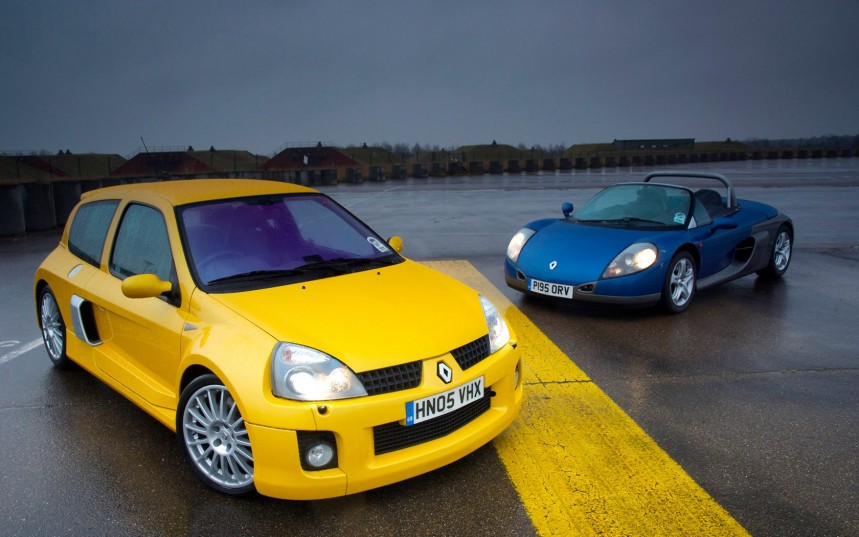When the concept car was unveiled at the 1998 Paris Motor Show, car enthusiasts were astonished by the audacity of placing a V6 in the middle of a beefed-up Clio. It looked great and performed even better, making it one of the most desirable hot hatches ever built.
Looking to promote the second-generation Clio, Renault introduced the Clio V6 Trophy series shortly after unveiling the concept. It toured some of Europe’s finest racetracks showcasing the heavily modified Clio V6 Trophy race cars, which rapidly gained popularity for being incredibly fun to drive and watch.
The specialized race Clios had few things in common with the concept version, using a slightly modified 2.9-liter V6 which produced 285 hp.
Since there was a lot of hype surrounding both the concept and the series, Renault tasked British-based specialist TWR (Tom Walkinshaw Racing) to do a preliminary development and production study. Based on the results, the carmaker decided to manufacture a limited number of cars.
The production version was developed using valuable feedback from the racetrack and started rolling out the factory gates in 2001.
Known as the Phase 1 Clio V6, it was reported by Renault Sport to be 98% faithful to the concept car, much to the delight of motoring enthusiasts.
It used a rear-mid engine, RWD layout, just like the ‘80s Renault 5 Turbo it paid homage to and totally unlike the standard front-wheel-driven Clio it was based on.
Compared to the stock model, the Renault Sport version was wider, lower, and a lot more aggressive-looking. Underneath the body, everything was completely different.
Power was delivered by a naturally aspirated 2.9-liter V6 derived from the unit used in the Renault Laguna, though it came with many modifications like reinforced pistons and enlarged inlet ports that led to an increased compression ratio and thus more power.
Though not as powerful as the Trophy version, it still developed 230 PS (227 bhp; 169 kW) and 300 Nm (221 lb-ft) of torque. This was good enough to enable the Clio V6 to accelerate from 0 to 100 kph (0-62 mph) in only 6.4 seconds and reach a top speed of 237 kph (147 mph), figures that were surprisingly better than those of the Trophy racecars.
To channel the power of the engine to the rear wheels, a six-speed manual gearbox was developed from an existing five-speed unit. Dubbed PK6, it was equipped with a completely new internal control mechanism.
A limited-slip differential was used to effectively transfer the power to the rear wheels, which, combined with the short wheelbase and a lack of traction control, delivered an exhilarating driving experience that made the Clio V6 so desirable.
Although it was performance-focused, the car featured a level of equipment that could rival that of any luxury sports car. The interior came with leather/Alcantara trims, air conditioning, a Radiosat 6000 six-CD changer, a heat reflective windscreen, and tinted windows.
All 1,631 Phase I cars were hand-built by Tom Walkinshaw Racing (TWR) at its workshops in Uddevalla in Sweden. Among those, 256 were right-hand-drive models.
With the release of the facelifted Clio in 2001 and the major success of the high-performance model, Renault Sport introduced the Phase 2 Clio V6 in 2003.
It had a revised version of the same engine that made it more powerful. It produced 255 PS (252 bhp; 188 kW), which at the time made the upgraded Clio V6 the most powerful hot hatch to ever be mass-produced.
Other modifications included a revised chassis with a longer wheelbase and a wider front track, firmer suspension, and the addition of stiffer subframes, making the already great car handle even better.
It was built for another two years in 1,309 units with production being relocated to Renault Sport’s Dieppe factory. Just like the Phase 1 models, all upgraded Clio V6 cars were hand-built.
Fifteen years have passed since the last model rolled off the production line and the Renault Sport Clio V6 has become a modern-day performance classic, with surviving models being highly sought after.
Its success paved the way for the newer Clio and Megane R.S. performance cars. Without a doubt, the Clio V6 will go down in history as one of the greatest vehicles ever manufactured by the French carmaker in its 122 years of existence.
The specialized race Clios had few things in common with the concept version, using a slightly modified 2.9-liter V6 which produced 285 hp.
Since there was a lot of hype surrounding both the concept and the series, Renault tasked British-based specialist TWR (Tom Walkinshaw Racing) to do a preliminary development and production study. Based on the results, the carmaker decided to manufacture a limited number of cars.
The production version was developed using valuable feedback from the racetrack and started rolling out the factory gates in 2001.
It used a rear-mid engine, RWD layout, just like the ‘80s Renault 5 Turbo it paid homage to and totally unlike the standard front-wheel-driven Clio it was based on.
Compared to the stock model, the Renault Sport version was wider, lower, and a lot more aggressive-looking. Underneath the body, everything was completely different.
Power was delivered by a naturally aspirated 2.9-liter V6 derived from the unit used in the Renault Laguna, though it came with many modifications like reinforced pistons and enlarged inlet ports that led to an increased compression ratio and thus more power.
Though not as powerful as the Trophy version, it still developed 230 PS (227 bhp; 169 kW) and 300 Nm (221 lb-ft) of torque. This was good enough to enable the Clio V6 to accelerate from 0 to 100 kph (0-62 mph) in only 6.4 seconds and reach a top speed of 237 kph (147 mph), figures that were surprisingly better than those of the Trophy racecars.
A limited-slip differential was used to effectively transfer the power to the rear wheels, which, combined with the short wheelbase and a lack of traction control, delivered an exhilarating driving experience that made the Clio V6 so desirable.
Although it was performance-focused, the car featured a level of equipment that could rival that of any luxury sports car. The interior came with leather/Alcantara trims, air conditioning, a Radiosat 6000 six-CD changer, a heat reflective windscreen, and tinted windows.
All 1,631 Phase I cars were hand-built by Tom Walkinshaw Racing (TWR) at its workshops in Uddevalla in Sweden. Among those, 256 were right-hand-drive models.
With the release of the facelifted Clio in 2001 and the major success of the high-performance model, Renault Sport introduced the Phase 2 Clio V6 in 2003.
Other modifications included a revised chassis with a longer wheelbase and a wider front track, firmer suspension, and the addition of stiffer subframes, making the already great car handle even better.
It was built for another two years in 1,309 units with production being relocated to Renault Sport’s Dieppe factory. Just like the Phase 1 models, all upgraded Clio V6 cars were hand-built.
Fifteen years have passed since the last model rolled off the production line and the Renault Sport Clio V6 has become a modern-day performance classic, with surviving models being highly sought after.
Its success paved the way for the newer Clio and Megane R.S. performance cars. Without a doubt, the Clio V6 will go down in history as one of the greatest vehicles ever manufactured by the French carmaker in its 122 years of existence.













